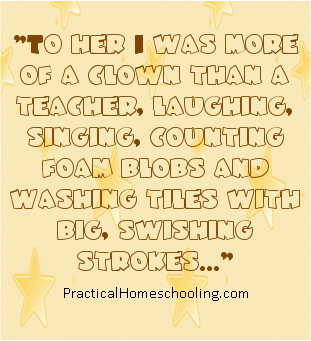Hi, I'm Peggy Barker. Mary has asked me to share some ideas with parents who home school their special needs children.
 Twenty-three years ago, the Lord gave us just such a child -- Jennifer, our fifth. She was diagnosed at birth and confirmed by chromosome evaluation at six weeks to have Down Syndrome. Hers is the most common of the three types, the trisomy 21 type. She falls into the mildly to moderately retarded range, with an IQ in the vicinity of 45-52, some areas of ability being higher than others.
Twenty-three years ago, the Lord gave us just such a child -- Jennifer, our fifth. She was diagnosed at birth and confirmed by chromosome evaluation at six weeks to have Down Syndrome. Hers is the most common of the three types, the trisomy 21 type. She falls into the mildly to moderately retarded range, with an IQ in the vicinity of 45-52, some areas of ability being higher than others.
While I did not actually home school Jennifer in the sense of conducting systematic, progressive courses of academic study in the place of conventional schooling, nevertheless, home was definitely her early education classroom setting. It was here that we focused on developing a stimulating environment, and on building into her muscles and senses an awareness of what was going on and what she could do.
In the late 60s and early 70s, the concept of Infant Stimulation was coming on strong. This involves, for example, using bright, well-defined objects the child can follow with her eyes, and getting her to listen to whistling and other sounds, and to touch and feel a variety of textures, naming each as she is exposed to them. Special emphasis is placed on passively exercising all the major muscle groups in fun but regular ways. These actions are designed to heighten your child's awareness of her surroundings and of herself.
As Jennifer grew a little older, the most natural setting for doing most of this seemed to be the bathtub, where the great possibilities of water play occurred to me. Early activities included gently pouring water from a plastic cup and saying "Tummy!" as it hit her there, then doing the same thing on her leg, arm, and scalp, naming them as we went along. The bath is also ideal for gross motor work such as kicking, splashing and creating waves, which involves the muscles, especially of the legs.
Later as Jennifer was able to sit, I took a can of shaving foam and squirted tiny puffs on her body parts, trying to make her name them and splash them off. Shaving foam was also a great tool for pre-writing skills. I squirted some on the tile, spread it around, and showed her how to make hand prints, how to make big, fanning designs, and how to do "round and round" circles, loops, zig-zags, and up and down motions, with verbal cues.
The next stage was to draw a face (circle) and finger paint one or two features (e.g., eyes or nose) and have Jennifer supply the mouth, etc., using a finger painting action. This reinforced not only recognition, but also the "what's missing" perception, which requires definite concentration.
The bathtub was also well-suited for further refinement of fine motor coordination skills. I began by showing her how to pour water from one container into another. As she did this I supplied appropriate descriptions, such as full-empty, big-little, in-out, etc. Then she learned to pour more accurately from and into containers with smaller openings, until she could do very well in a happy and forgiving atmosphere.
We even worked on number recognition, values, and counting, with blobs of foam on the tile, Next came letter-shape recognition along with the phonic alphabet sounds. We didn't actually memorize the ABCs because it seemed to me that she would have to unlearn them later.
To her I was more of a clown than a teacher, laughing, singing, counting foam blobs and washing tiles with big, swishing strokes, while we each thoroughly enjoyed the other. I believe her first "classroom" experience prepared Jennifer to be a more attentive learner and to enjoy her growing awareness of her surroundings, as well as her sense of personhood.